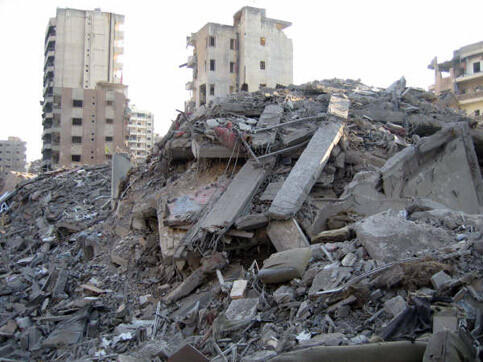IRIN 1 September 2006

The aftermath of Israel’s bombing campaign in Dahiyeh, southern Beirut (Mayssoun Sukarieh)
Lebanon response OCHA situation report No. 36
Situation Overview
1. The Government of Lebanon (GoL) Higher Relief Council (HRC) reports the casualty figures at 1,187 killed and 4,092 injured.
2. Between 35 to 50% of the South territory has no electricity supply which is having a significant impact upon the restoration of essential and municipal services and is limiting south Lebanon’s ability to restore economic activity. Many returnees will be discouraged from staying and may seek opportunities to re-establish their lives elsewhere.
3. As of August 31, the UN Mine Action Coordination Centre (MACC) reports that 405 individual cluster bomb strike locations have been identified. Given that areas of lower priority have yet to be visited and investigated, as well as a number of villages due to the presence of IDF troops, it is estimated the total number of strikes locations may ultimately be as many as 500.
4. The MACC reports that casualties from UXOs now stand at 48 injured and 13 killed.
5. UNHCR engineers are continuing with the assessments of damaged houses in the area around Tyre and have also started with the assessment of shelter in the areas of Nabatiyeh and Saida.
6. WHO reports that there is no need for additional medicine to be supplied by donors as the supplies in Lebanon are now sufficient.
Humanitarian Response
Humanitarian Hub Update - Tyre
7. The GoL electricity authority, Electricite’ du Liban, (ETL) has 14 teams across Lebanon working to repair damage to the electrical system. The main substations in South Lebanon were not damaged during the conflict. Repairs of the main power lines and switches are expected to be completed in the next week.
8. The next step is to repair distribution of electrical power within towns where extensive damage of electrical transformers has occurred. For example, in Bent Jbeil only 3 of the 35 transformers are operational and only 25 per cent of the damaged transformers are repairable. In Khiam, only 4 of its 27 transformers are operational. Until repairs are made upwards of 90 per cent of people in the towns will remain without electricity.
9. Across South Lebanon the electricity authority estimates that 150 transformers (250 KVA 1500HT/380/220volts) will need to be replaced. Each transformer costs approximately US$6,000, with a total cost of approximately US$900,000.
10. Currently only five to 10 suitable transformers are available within Lebanon. The production of locally manufactured transformers will take at least five months from when orders are placed. If an alternate source of transformers is not secured, electricity will not be distributed to a large proportion of households in South Lebanon that incurred the most damage during hostilities. Currently in Bent Jeail and Khiam Dstricts 85 to 90 per cent of households have no access to electricity, and across South Lebanon 35 to 40 per cent of households are without electricity at least for the medium term.
11. A second consideration regarding restoration of electricity is that much of the repair work is stop-gap. For example, in repairing the main line, approximately 15 kilometres, between Tyre and Naquora, upwards of 300 individual breaks have been rejoined in a temporary measure. This leaves the line very vulnerable, particularly with the onset of winter. Concern also exists regarding wiring with some of the repairs using substandard aluminum wire rather that copper, as copper wire is in short supply.
12. A significant concern exists among electricity workers about a high concentration of UXO that has been cleared from roads and now lies beside the roadway and under the route of the power lines. The Lebanese Army is working in close collaboration with the electricity authority to identify and destroy such unexploded ordnance, however in areas within 10 kilometres of the Blue Line they can not operate due to continued IDF presence. OCHA Tyre is establishing coordination between MACC - Tyre and the electricity authority to help clear routes for electricity workers.
13. Currently 14 villages are without power because the IDF has denied access to a damaged switch near Aalma and 300 metres of damaged line near Chamma. The OCHA CMCoord Officer in UNIFIL HQ is currently addressing this issue.
14. The restoration of sufficient water supplies depends upon electricity to power pumps that supplement the community’s water supply. Currently the three main regional water pumping stations - at Ras el Ain, Taibe and Siddiqine — are operational and once water pipes are repaired communities across South Lebanon will receive water to community water reservoirs. However, the main supply is insufficient and needs to supplemented. Communities with no electricity to pump supplementary water from local wells will therefore have a water deficit.
Related Links